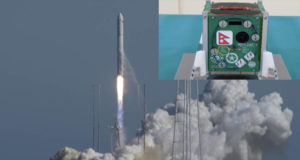 JNS: Nepal’s first nanosatellite ‘NepaliSat-1’ was launched into space on April 18, 2019, at 2:30 AM NPT from NASA’s Wallops Flight Facility in Virginia. The launch marks Nepal’s entry into the global space age.
JNS: Nepal’s first nanosatellite ‘NepaliSat-1’ was launched into space on April 18, 2019, at 2:30 AM NPT from NASA’s Wallops Flight Facility in Virginia. The launch marks Nepal’s entry into the global space age.
The satellite was developed with the support of Japan’s Kyutech University under the Birds project, which is a cross-border interdisciplinary satellite project for non-space faring countries.
The satellite weighs about 1.33kg and is just around 30 percent larger than a Rubik’s cube. This satellite will capture pictures of various parts of Nepal and share information about its forests, glaciers, hills, mountains, roads and more, Nepali media reported.
Chief of Technology Faculty of Nepal Academy of Science and Technology (NAST) Rabindra Prasad Dhakal said that Nepal’s satellite has been successfully launched.
He said that the satellite has now reached the space and it would be linked with the International Space Station at 3:30 am on Friday.
Dhakal further said that process has been forwarded through Foreign Ministry for the registration at United Nations Office for Outer Space Affairs (UNOOSA).
The nano-satellite built under project ‘Birds-3’ by two Nepali engineers Awash Maskey and Hareram Shrestha pursuing space engineering in the Kyushu Institute of Technology (Kyutech) University in Japan have been launched from a facility in USA.
Under the ‘Birds-3’, Nepal’s first ever satellite (Nepali Sat-1) has been released into space along with Sri Lanka’s ‘Ravan-1’ and Japan’s ‘Ubishu’, were taken to the International Space Station (ISS) and boarded onto the Antares rocket.
Following the successful launch of Nepal’s first satellite, Prime Minister KP Sharma Oli took to social media and expressed his happiness over Nepal’s this success.
“Nepal’s first satellite ‘Nepali Sat-1’ has been successfully launched today at 2:31 am. With this, Nepal has joined the countries that have launched their satellites. I congratulate all sectors including scientists and the NAST who have involved in the endeavor on achieving this success,” he twitted.
Let's Make things Better



